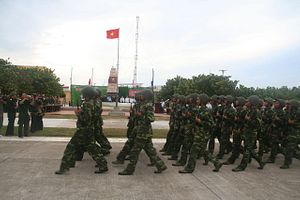Vietnam has shifted its strategic attention to the sea, but what can it hope to accomplish against China’s array of aircraft and warships? In a recent Naval War College Review article, Wu Shang-su, research fellow at Nanyang Technological University, examined why Vietnam has turned to the sea, how it has decided to approach defense against China, and what it might do in the future.
Vietnam began to shift its strategic attention to the sea in the years following the Sino-Vietnam War. The inconclusive nature of that war, combined with a relatively amicable process of border delineation with China, convinced Hanoi that China would no longer pose a critical threat from the land. The People’s Army of Vietnam (VPA) held presumptive superiority over the armed forces of Laos and, following withdrawal, Cambodia, making those borders relatively safe, as well.
At the same time, Vietnam’s economic strategy developed in two directions that made a maritime focus appealing. First, Vietnam began to integrate itself more heavily into the global economy, making access to shipping a critical need. Second, Vietnam became increasingly interested in exploiting offshore resources, which required the defense of islands and other geographic features in the South China Sea.
This shift to the sea came as Beijing began the massive military buildup that continues to this day. At the extreme, China could attempt a full blockade against Vietnamese ports, but more likely any conflict would involve fights over island outposts. With an economy a small fraction of its northern neighbor’s, and a small defense industry, Vietnam’s options were limited. However, Hanoi borrowed pages from Soviet (and Chinese) Cold War maritime strategy, focusing on capabilities that could deny the sea to the Chinese, or at least deter China by threatening serious damage to the PLAN.
Vietnam has the weapons necessary to destroy Chinese aircraft and warships. Air-, sea-, and land-launched missiles can inflict grievous damage on major PLAN assets, just as long-range SAMs can threaten the PLAAF’s most expensive warplanes. The problem is that Vietnam lacks the surveillance assets necessary to deliver good targeting data to its long-range weapon systems. The Vietnamese military has limited access to satellites, a shortage of patrol aircraft, and a dearth of advanced, long-range sensors. This makes it very difficult for the Vietnamese military to identify, target, and destroy Chinese ships and planes.
Dr. Wu also suggested that Vietnam’s dependence on Russian weaponry could hamper the effectiveness of its resistance efforts. Most of Vietnam’s most advanced weapons, including late model Flanker variants, Kilo submarines, and S-300 air defense systems, come from Russia. Unfortunately, China has in most cases acquired exactly the same systems from Russia, and often has more familiarity with them. This familiarity undercuts some of the advantages that the Vietnamese might derive from these systems.
Together, these concerns lead in the same direction: the diversification of Vietnamese military procurement, with a focus on reconnaissance technology. Vietnam has already reached out to India, the Netherlands, and most recently to the United States in order to meet these needs. However, whether Vietnam can make the long-term commitment to increased spending in order to deter China remains in question.

































